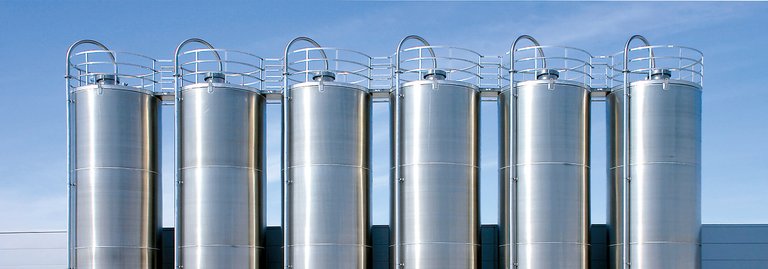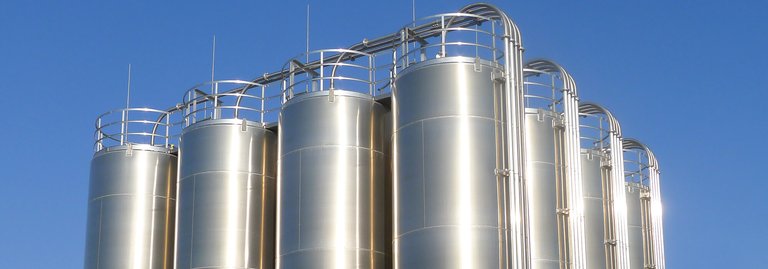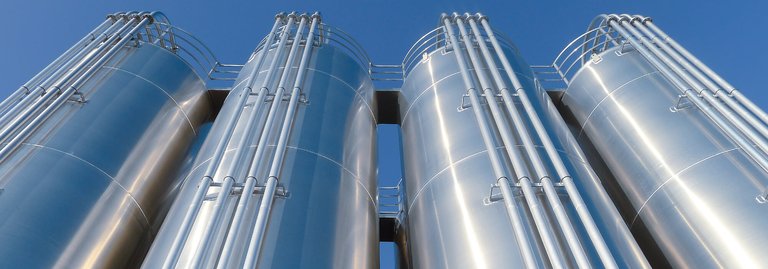


Our storage silos, double chamber silos, mixing and homogenization silos as well as loading silos are made of aluminium and stainless steel. Silo plant construction at ACHBERG starts with a needs assessment and ends with after-sales service.
We unload, store, mix and load your high-grade bulk material safely and economically. While doing so, we take into account the unique properties of your bulk material in terms of wear, flow characteristics, moisture absorption and inflammability. The control technology is planned, programmed and produced by us, and ensures reliable operation of the plant components and proper function of the silo system.
This illustration shows a common material supply in an injection moulding company for technical plastic parts. The plastic granules are stored in silos, conveyed to the dryers and then distributed to the individual injection moulding machines. Our silos and small containers protect your high-grade plastic granules from contamination. The coupling tables and pipe systems are professionally installed by our partners (manufacturers of central material feeding systems), whereby coupling tables from ACHBERG can be equipped with coding (RFID technology) on request.
In order to be able to track batches, it is imperative to store raw materials separated by batch. Each batch delivered by a silo vehicle (approx. 25 tonnes) is filled into a separate silo chamber. The material is also removed separately for each batch. After the silo chamber of batch A has been emptied, an automatic or manual switchover to the silo chamber of batch B takes place. To achieve this, our specially developed pneumatic slides at the suction point of the silo suction boxes open and close. The process is controlled and monitored via the touch panel or our silo control. Batch switching can also be logged on request, and an interface to a higher-level controller of the material feeding system can be provided.
Plastics are collected, washed, shredded, dedusted and fed to the extruder as single-type regrind. After the extrusion process, the regranules are homogenised in mixing silos before being filled into big bags or silo vehicles. We design and realise silo systems that are precisely tailored to your production processes.
The buffer must be dimensioned so that the silo never runs empty. The buffer is calculated from the daily consumption (tonnes) and the procurement time (days).
The delivery quantity (capacity of the silo vehicle) is 25 tonnes. The bulk density was assumed to be 0.6 tonnes/m³ in the example calculation.
Silos should always be designed for mass flow. When storing free-flowing plastic granules, a cone angle of 60° is required. The plastic granules are then removed according to the FIFO method (first in, first out), which entails no notable batch mixing.
The storage of bulk materials with limited or poor flow characteristics can result in flow problems. We thus recommend carrying out bulk material analyses in order to select a suitable silo geometry based upon the determined characteristics of the bulk solid, and to ensure that the bulk material can be safely discharged. The result of the specific silo design may require a cone angle below 60° (e.g. 50° or 40°) to achieve mass flow.
With highly abrasive plastic granules (glass fibre content), a cone angle of 90° is beneficial, as this produces a funnel flow in the silo. The speed of flow is thus higher in the centre compared to the wall of the silo, which diminishes friction and wear on the silo wall and the discharge hopper. Silos with a cone angle of 90° also have a larger storage volume compared with a silo of the same hight and a cone angle of 60°, because a greater cylindrical filling height is available.
Cone angles of 90° are frequently selected with double chamber silos for batch splitting. There are no disadvantages with regard to batch mixing, as only one batch per silo chamber is stored and completely emptied. The benefit of having a greater storage volume particularly comes to the fore when two hoppers are welded into the double chamber silo.